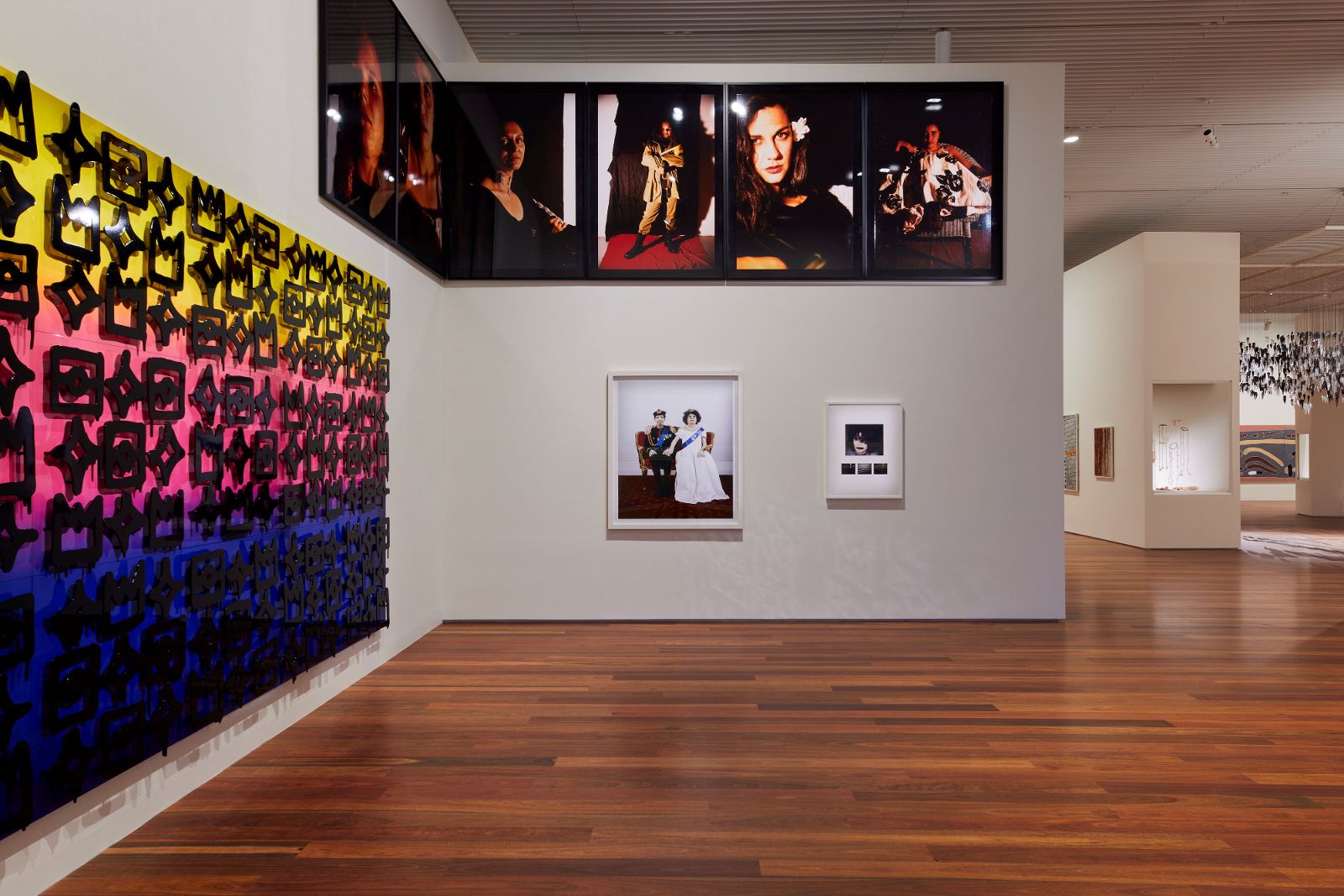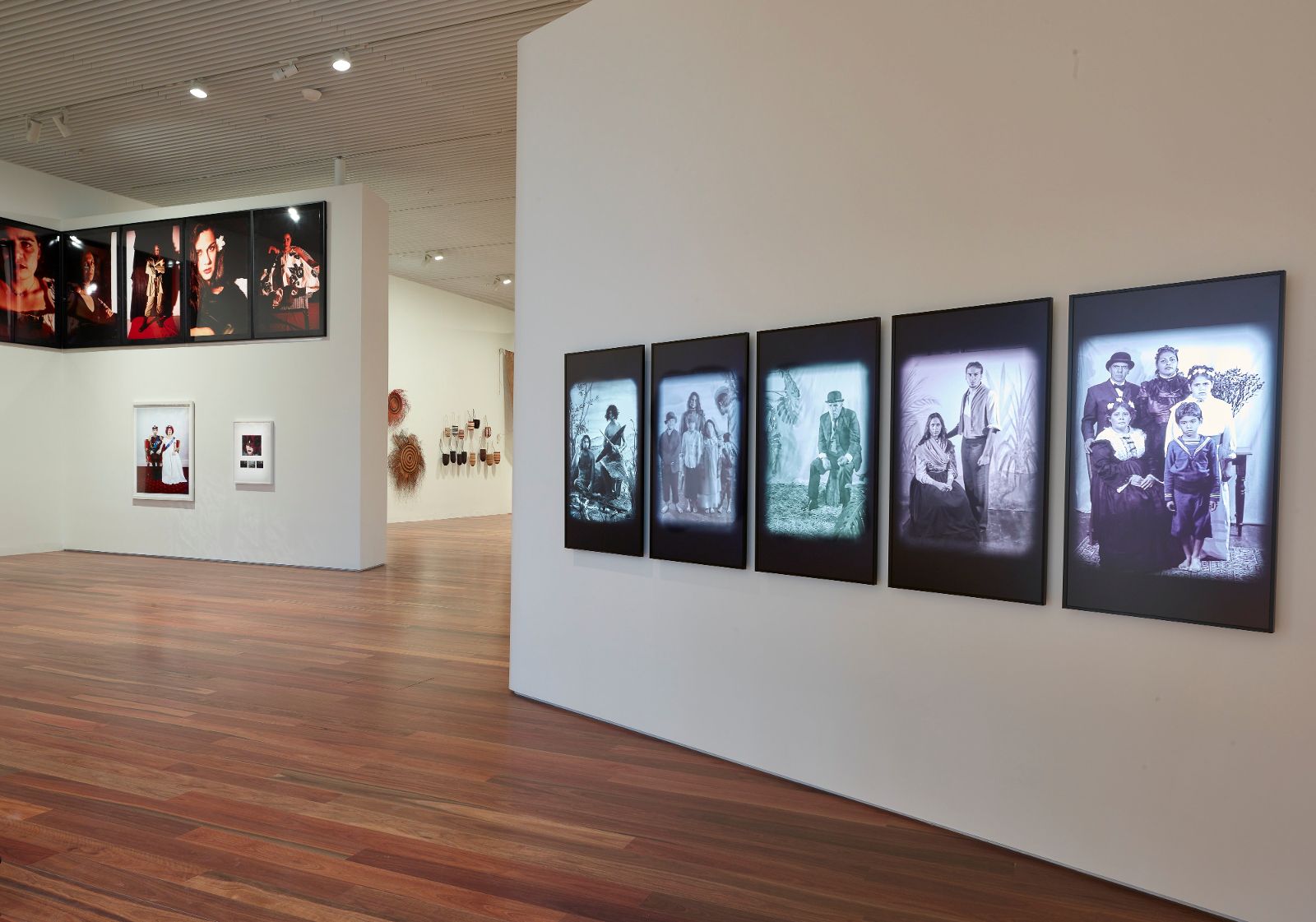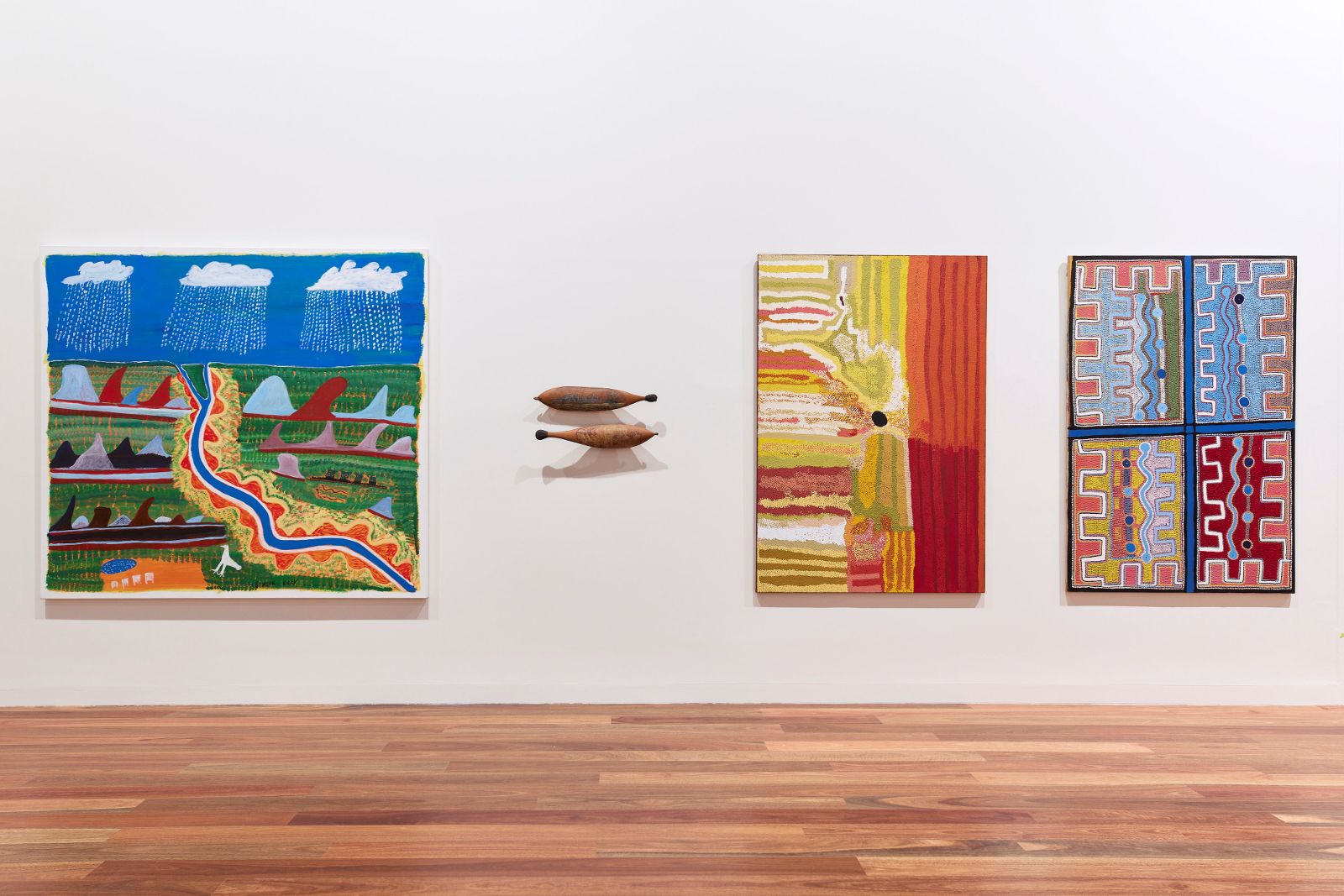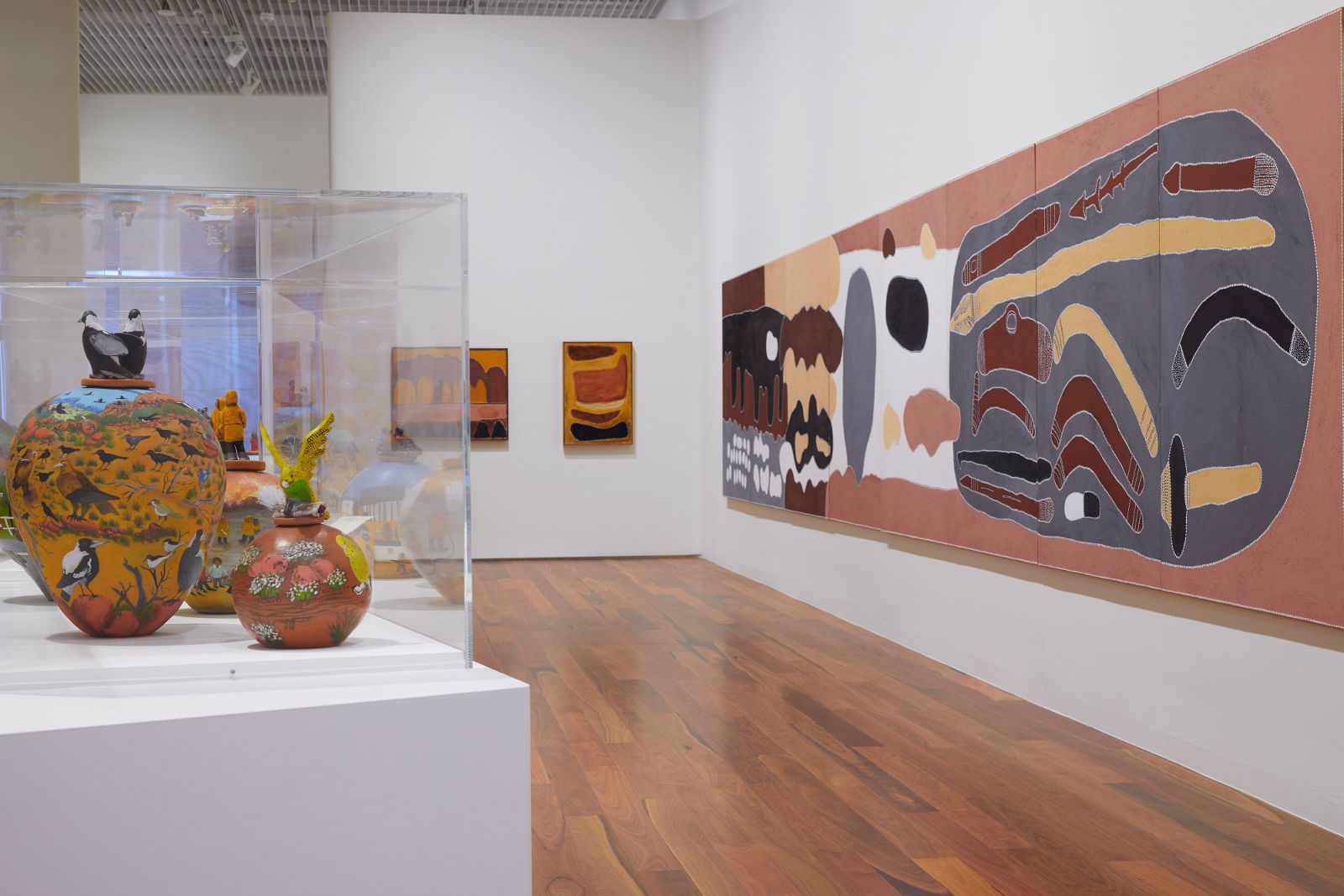
Entering the new Sydney Modern building of the Art Gallery of NSW, we—an Indigenous curator and a diasporic settler and academic—were happily surprised with Yiribana’s new location on the building’s entrance level, a grand and generous courtyard with an open lobby feel. Finally, Indigenous art has been removed from the basement of the South Gallery (the old AGNSW building) and elevated to the status it deserves.
As the wall-text and media release explains, ‘the new Yiribana display is inspired by a word from the Sydney language, burbangana’, to ‘take hold of my hand and help me up’. Agreeably, Yiribana in its current collection exhibition does justice to the Indigenous ethics of care and guidance evoked by burbangana, as the works are arranged in powerful and affective dialogue: with each other, with Country, and with the larger cultural and historical contexts from which they emerge. Visitors, in turn, are invited to join in this embracing vision.
While we were approaching Yirabana, looking at the well-represented Rusty Peters Gamerre– What’s this Museum? (2004) in the entrance pavilion, the mechanised curtains of the entrance doorway suddenly opened. Unfortunately, this did not allow for a detailed viewing of Peters’ important cross-culturally instructive work, as the mottled light that fell onto the painting was distracting.

Entering Yiribana itself, we were greeted with Genevieve Grieves’ innovative Picturing the Old People (2005). Positioned at the threshold, this is an inspired move on the part of the curators led by Cara Pinchbeck and Erin Vink, as it (and other photographic works nearby) powerfully establishes a dialogue between past and present. Playing with the conventions of nineteenth century ethnographic photographs of Aboriginal people, Grieves disrupts the fixity of colonial modes of representation by animating these daguerreotype images with living, contemporary Aboriginal people who effectively speak back to white systems of representation and, in the process, reclaim self-representation.
Elevated in the same space, Michael Riley’s evocative and peaceful Cloud (2000) photomontage series of floating feathers, cows, bibles and boomerangs was effectively offset by Reko Rennie’s repetitively patterned Regalia (2015). Facing the Riley work, positioned high up in the corner space of this room and acting as a type of embrace to the Riley works was fellow Boomalli Aboriginal Artist’s founding member Brenda L. Croft's photographic portraits from her Strange Fruit (1994) series. Below Crofts’ work was a small-scale installation of photographs companioning the larger works around them: Destiny Deacon’s Dreaming in Urban Areas (1993) coupled with Darren Siwes’ Jingli Kwin, (2013). The staging of these works together opens up a series of transnational dialogues with African American art that references histories of anti-Black violence and the transmutation of racial trauma into a political aesthetic that commemorates those killed, while staging acts of defiance and reclamation—such as in the work of Carrie Mae Weems, Kara Walker, and the song ‘Strange Fruit’ first recorded by Billie Holiday in 1939, which became an iconic protest song during the civil rights movement.
Adjacent to the photographic material, we found ourselves in a space with works by artists from the Pitjantjatjara, Southern Desert region. Fred Grant, Ned Grant, Patju Presley, Lawrence Pennington and Simon Hogan’s 2019 collaborative canvas, Wati Kutjara and Dickie Minyintiri’s Kalaya Kalaya, (2011) facing off against Richard Bell and Emory Douglas’ painting We can be heroes (2014). Politically and stylistically, these artworks are in a creative and illuminating dialogue: not often do we see works from the desert regions hung so beautifully and so powerfully with works that display an overt political statement, and this in itself is the illuminating factor for visitors. It shows that the two can and should sit together.

Also sharing this room were soft sculpture figures by Trudy Inkamala, Marlene Rubuntja and Rhonda Sharpe, uber-cool pieces given a prominence rarely granted to fibre artists or their work. Placed centre-stage, their vibrant colours and intricate textures have been given the space to shine. It was wonderful to have the opportunity to walk 360 degrees around these three sculptures, as this allowed an intimate view into the designs and the superiority of the execution.
During Allas’ tenure as an assistant curator at the Art Gallery of NSW, working alongside Ken Watson in 1997, Yiribana was fortunate to secure two wooden woomeras embellished with watercolour painting by Albert Namatjira. Dated circa 1944, the carved and decorated objects show the depth and range of his practice. It was an emotional experience seeing these works again, as they are inscribed with the artist’s fraught personal history. Similar feelings were experienced when looking at Ginger Riley Munduwalawala’s 1997 masterpiece, Nyamiyukanji, the River Country next to Namatjira’s woomeras. The new hang rightly honours these two legends of Australian art and its history and reinforce burbangana.
Nearby, Roy Kennedy’s Untitled (c1999) painting depicting a scene from his childhood growing up on Police Paddock Mission in the Riverina district of NSW. Kennedy’s ouvre, be it ceramics, printmaking or painting, was always informed by his life on the mission or that of his mother’s life on Warangesda Aboriginal Mission. The work currently on view, with its telling of another river country (the Murrumbidgee), is perfectly placed next to Munduwalawala’s painting that speaks of his own river country story.
.jpg)
Esme Timbery’s tiny yellow shell-worked Sydney Harbour Bridge (2002) sculpture sits beautifully with her fellow La Perouse shell-worker, Lola Ryan’s shellwork pink and white relief-work, Untitled bird (galah ) (2000). Seeing these together was a wonderful experience and the placement of Elaine Russell’s Inquisitive Child (1994), above the shell-works was a stroke of genius: as some of Russell’s life was spent at La Perouse and she would have been familiar with the two women artists she now sits in concert with. And as her work depicts the memory of life on the mission and is situated appositely next to Kennedy’s mission work, it is also in intimate conversation with the historical narrative of the times in our nation when Aboriginal people were forced to live an apartheid existence. As the AGNSW holds works by Kempsey Koori artists Milton Budge and Robert Campbell Jnr, whose paintings portray this history explicitly, it was a missed opportunity not to situate them here.
When we moved into the darker ‘galley’ type space that houses works by Grace Lillian Lee from the Torres Strait Islands with her dramatic Belonging, series 2021-2022, we met forms that, as the wall-text explains, explore ‘the complexities of identity and connection’. These sculptured, armoured adornments are dramatically installed in a jet-black alcove. The brilliant white and magenta colours of the works make them appear to ‘jump’ out of the dark recess. Opposite is fellow Torres Strait Islander Glen Mackie’s The Githalai Effect I, 2015, a vinyl cut print on a long paper scroll. Here again the coupling of works from artists who have relationships with each other—that they are from the same country, are concerned with similar themes or speak to shared political histories—was palpable. Another example was the work of Queenie McKenzie positioned next to Rover Thomas. These two artists were close friends in life and now (as co-reviewer Tess Allas did in curating With Secrecy and Despatch at Campbelltown Arts Centre in 2016), the curators have lovingly brought them together once again, placing McKenzie’s Untitled (c1994) ochre landscape with Thomas’ Two Men Dreaming (c1985). We acknowledge this act of grace and care.

The coupling continues with two artists from different areas of the Central Desert, Vincent Namatjira whose paintings are presented in the video Prime Ministers & Vincent Lingiari, (2016, produced by Iwantja Arts and directed by Namatjira), alongside Sally M Nangala Mulda’s narrative paintings. With titles such as Women Eating Supper at Night Time and Two Men Talking Story at Town Camp, the added interest here is the clever hanging of these works which can be read as individual pieces or as a snapshot of Mulda’s life and world.
Vernon Ah Kee’s small charcoal on canvas work Unwritten #9 (2008) is coupled with Yhonnie Scarce’s monumental glass installation Death Zephyr (2017), which, through its positioning in the gallery space, throws intense shadows around Ah Kee's drawing. This is a brilliant juxtaposition as the haunting silhouettes of Scarce’s glass drops hover over Ah Kee’s powerful canvas. Sitting quietly to the side of this coupling is Vicki West’s modest installation of three kelp Water carriers (2011). They have been thoughtfully placed in their own glassed-in alcove, where the lighting throws its own delicate shadows of the kelp water carriers. Situated in this alcove, West's quietly beautiful artwork is allowed to occupy its own meditative space without being disturbed or distracted by the presence of other works.
Opposite Rusty Peter’s Waterbrain (2002), Emily Kame Kngwarreye’s equally monumental Untitled (Alhalker) (1992), was let down terribly by the sunlight cast directly across the canvas from an unshaded window. Disturbingly, we felt a real need to rescue this work along with the Kennedy and the Peters works mentioned previously, which were all soaked in the direct light of the afternoon sun. There are genuine conservation issues at stake here that immediately need addressing.
In the gallery space with views north across the harbour was a small-scale Julie Gough work, Bind, 2008. We are still perplexed at Yiribana’s minimal representation of one of Australia’s most important contemporary artists; Gough has broken new ground across decades of work in exposing and speaking back to this country’s buried histories of Indigenous genocide, the Frontier Wars, the theft of Indigenous lands and the colonial kidnapping of Indigenous children. This singular installation, and the absence of any major Gough work that pivots on these urgent themes, is a stark gap in the gallery’s collection.
.jpg)
More positively, sharing the room with Gough was a stunning series of recent works on various metals created by Yolngu artists Wanapati Yunupiŋu, Barayuwa Munuŋgurr, Wukun Wanambi and Gunybi Ganambarr all from Yirrkala, in northeast Arnhem Land. This is an extraordinary series that marks out a new direction in contemporary Indigenous art. Working with previously painted sheet metal, including road signs, the artists have, through techniques of scratching, engraving and painting, transformed them into vibrant pieces reminiscent of traditional bark paintings—with a brilliant twist. There is a breathtaking sense of innovation and continuity in these works initiated by Gunybi Ganambarr and now a distinct local practice.
While the floor-size of the new space is improved from the old basement-level Yiribana, (now a vast, accessible research art library and archive), there could have been a larger dedication for works of such unique global significance. However, it was appreciated, that throughout the rest of Sydney Modern’s contemporary gallery spaces— and in the South Building’s colonial galleries—Australian First Nations art was curated into different collection hangs. Not only does this position these works as Indigenous art works, but as works that can seamlessly be considered alongside works by their artist-contemporaries from across the world.
